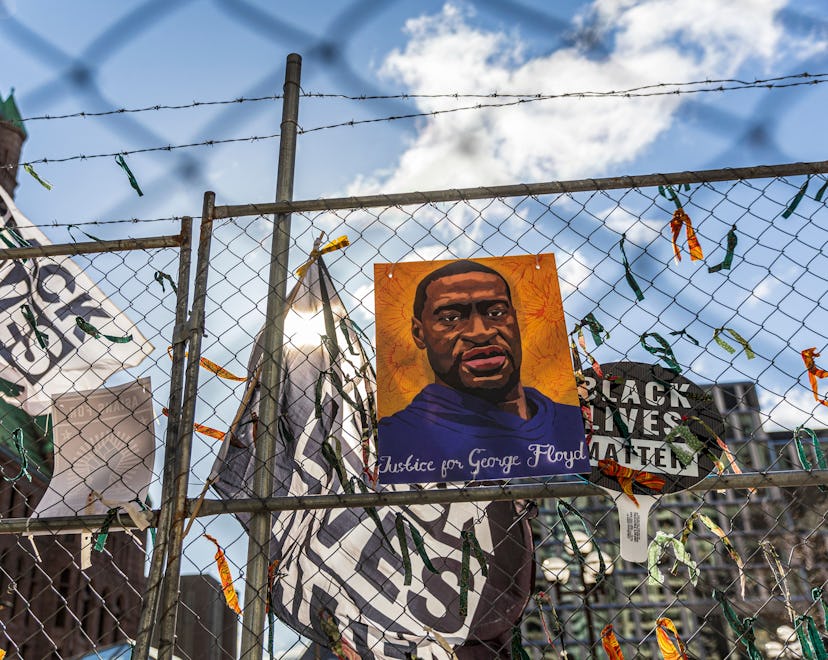Racial Justice

It Was Children Who Bore Witness To George Floyd's Murder And Testified In Court
We can't see their faces, but they will always see his.
The trial of Derek Chauvin, the ex-police officer who killed George Floyd in Minneapolis, began this week, and people around the country are watching to see if justice will be served. But they aren’t always prepared for what they’ll hear.
On Tuesday, two witnesses took the stand to tearfully recount what it was like to watch Floyd slowly suffocate at the hands of a law enforcement officer. Unlike other witnesses for the prosecution, their faces were not visible in the televised footage. The judge kept them off camera because they are children.
Darnella, a 17-year-old, and her 9-year-old cousin Judeah (I’ve chosen to omit their last names for privacy), were getting snacks at Cup Foods in Minneapolis on May 25, 2020 when their lives changed forever. For almost 10 minutes, they were in the group of bystanders begging Chauvin to get his knee off of Floyd’s neck. Darnella recorded the incident; it was her video that went viral after his death, sparking months of racial justice protests and a worldwide movement. She made the video, she told Star Tribune last year, because “it was like a natural instinct. The world needed to see what I was seeing. Stuff like this happens in silence too many times.”
Although her face wasn’t visible, Darnella’s voice can be heard as she gave her testimony. After one question, in particular, there was a lingering silence, and then through tears, she spoke of the pain she has experienced since that day outside of Cup Foods.
“How has this experience affected you?” prosecutor Jerry Blackwell asked.
“There have been nights I stayed up apologizing and apologizing to George Floyd for not doing more and not physically interacting, and not saving his life. But it’s like not what I should have done; it’s what he [Chauvin] should have done.”
While millions have watched Darnella’s video, there are many who can’t, horrified at the unimaginable pain and helplessness Floyd must have felt. But these children have the event imprinted in their minds. What are their nightmares made of?
“Testifying in court can be emotionally difficult for children, but the key trauma is witnessing the violence that brought them into court,” Dr. Abigail Gewirtz, Ph.D., a child psychologist who practices in the Minneapolis - St. Paul Metro area, tells Romper. It is particularly heartbreaking that Darnella’s enduring trauma is guilt. Although her video of Floyd’s murder allowed the world to see what happened to him, she still carries a burden of responsibility that no person, especially a child, should have to endure.
“Children who witness violence can have nightmares about what happened, re-enact what they saw in their play, and/or avoid or show distress at reminders of the trauma — such as sirens, loud noises, uniforms, etc. They also may experience other symptoms of post-traumatic stress,” says Gewirtz.
Last year, in a television interview with KTNV Channel 13 News, 9-year-old Judeah said, “I wake up like four-something in the morning because every time I dream about it, I tell my mom. She gives me hugs.” Not only does she relive this in her sleep, on Tuesday, Judeah retold what happened outside of Cup Foods during the trial.
The prosecutor asked Judeah how watching Chauvin murder Floyd made her feel.
“I was sad and kind of mad.”
“And tell us, why were you sad and mad?” the prosecutor asked.
“Cause it feels like he was stopping his breathing, and it’s kind of like hurting him,” she replied.
The impact of this experience would be traumatic for any child, but for Black children, the distress inflicted is deeper.
“I can’t help but think about the many ways this experience is re-traumatizing them and having a major impact on the ways they perceive the world, the police, and their Blackness,” says Yolanda Williams, a parenting coach and founder of the podcast Parenting Decolonized. She understands why this testimony was necessary, but as the mother of a toddler, she found it viscerally hard to stomach. In American society, she says, Black children are expected to be resilient and to heal themselves. White children are often handled with fragility and cared for from empathy — given mental health care and emotional assistance. Black children aren’t afforded the same compassion. “Then adults are completely taken aback when those same [Black] kids start having behavioral issues at home or school.” And the trauma goes unaddressed.
For Williams, the trial offers another opportunity for the family conversations about race that may have just started last June. She advises parents to use current events to discuss the systemic oppression of Black people and what can be done to change it, even when it comes to how they view the police. “Being able to compare and contrast the different experiences of white and Black people by police helps to counter the messages of many books and cartoons that paint all police as friendly and helpful. For Black parents, the conversation needs to also include a discussion about their rights — rights to record, to remain silent, to demand an attorney, etc.”
And age-appropriate discussions could include a conversation about the vital role that Darnella and her cousin have played in showing the world what happened to George Floyd — and an acknowledgement that their mental health and healing should be prioritized and addressed promptly. Williams says that it is the responsibility of the state to subsidize their therapy “because if it weren’t for the state-sanctioned toxic police culture, there would be no reason these kids would have to testify in the first place.”
This article was originally published on